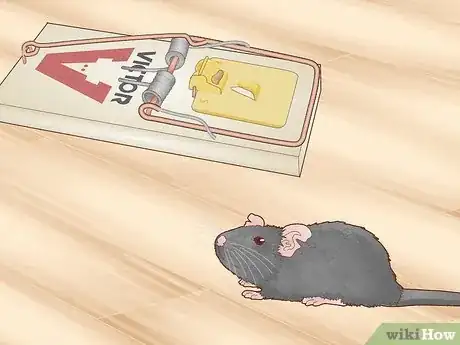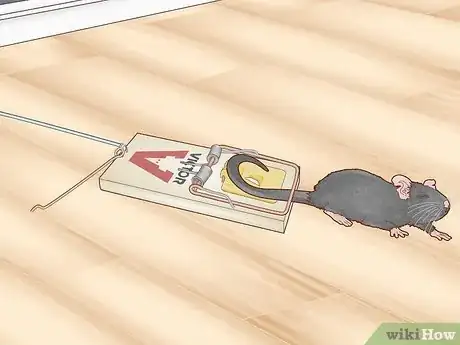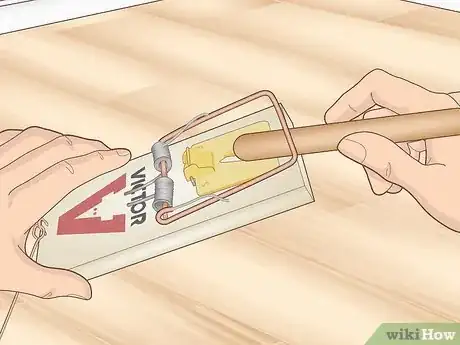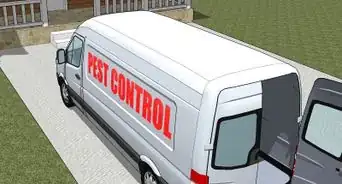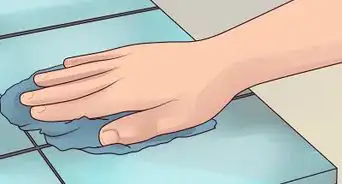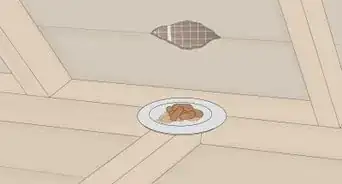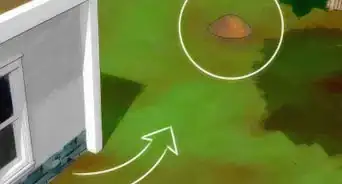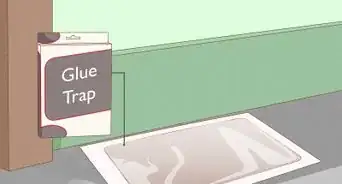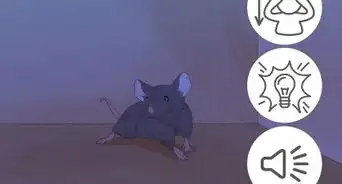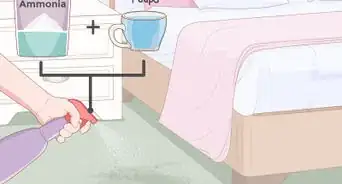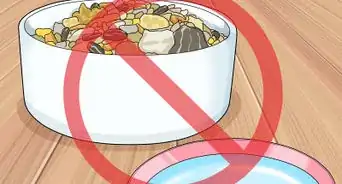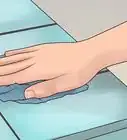This article was co-authored by wikiHow Staff. Our trained team of editors and researchers validate articles for accuracy and comprehensiveness. wikiHow's Content Management Team carefully monitors the work from our editorial staff to ensure that each article is backed by trusted research and meets our high quality standards.
There are 14 references cited in this article, which can be found at the bottom of the page.
This article has been viewed 30,400 times.
Learn more...
If you want a poison-free way to get rid of a rat infestation, Victor rat traps can catch rats quickly and humanely. Spring traps may seem difficult to set up at first but, once you know which parts to move, you'll be able to bait and set them within minutes. To avoid injuring your fingers, follow the packaging instructions on your Victor rat traps carefully. As long as you keep your hands out of the trap's strike zone, you should have no trouble putting it together.
Steps
Putting Together a Victor Rat Trap
-
1Release the armbar from the staple. The armbar, or holding bar, is the thin, hooked metal with a hook at the end. When the armbar is loosened, move the armbar over to the back of the trap so it hangs over to the back of the trap.[1]
-
2Add bait to your trap. Place the bait on the pedal in the middle of the trap. Bait your Victor trap based on your rat species' diets. The most common rats are black and brown rats. Black rats are herbivores and like fruit or peanut butter. Brown rats, however, are omnivores—they are more likely to be tempted by bacon, dry meats, or strong-smelling cheese.[2]
- Use a toothpick to keep your scent from touching the bait and scaring away rats.
- For most Victor rat traps, the pedal will be bright yellow.
- If your rat trap will not set, you may have added too much bait. Return to this step if you cannot set your rat trap and remove some of the bait.[3]
Advertisement -
3Set an easy set trap to "sensitive" for best results. If you have bought an easy set rat trap, you can pick 1 of 2 settings for your trap. Firm traps are easiest to set but harder to trigger. Sensitive traps are more effective but difficult to set.[4]
-
4Pull the kill bar back and hold it in place with your thumb. The kill bar is the rectangular metal piece along the top end of your rat trap. Take the armbar and lift it over the kill bar, latching it under the bait pedal.[5]
- If you have an easy set rat trap, set the kill bar as far back as possible to trigger the sensitive setting.
- Keep your finger and thumbs away from the inside area of the kill bar to avoid triggering the strike zone.[6]
Placing Your Victor Rat Trap Effectively
-
1Place the trap somewhere with plenty of rodent activity. Because rodents primarily travel near the wall, the baited petal should face that area. If you don't catch any rats after several days to a week, try moving your rat trap elsewhere.
- Secluded areas behind furniture or underneath outdoor debris are most likely to attract rats.
- Rodents rarely run in the middle of rooms. Keeping your traps in corners or by walls is your best bet for catching rats.
-
2Locate rat paths in your home and place traps alongside these paths. Inspect your home's walls and corners, as well as any dark or covered areas of the floor. Look for rat droppings or brown grease paths that look trampled down. These are areas with heavy rat activity, where you'll want to set your traps.[7]
- Rat paths are commonly found near walls, underneath furniture, inside closets, or within cabinets.
-
3Familiarize your rats with the traps before you set them. Rats are more cautious than mice and take time to trust traps. Leave your traps out for a few days with bait without setting them the rats grow comfortable around them. When you've noticed that the bait is gone, set the trap so that you catch the next rat that comes along.
-
4Oil dirty rat traps to increase their sensitivity. If your Victor trap doesn't seem to catch any rats, its spring may be getting old. Add a few drops of vegetable oil or bacon grease to the spring. Inspect your trap again after several weeks—if it still isn't catching rats, try placing it in another location or throw it away.
- Machine oil repels rats. Do not use it while oiling your traps.
- If your rat trap is dirty, use water—with no soap—to clean it off.[8]
Using Victor Rat Traps Safely
-
1Tie your traps down to keep rats from dragging away. If Victor traps do not strike the rat at the right angle, it might survive after it's been hit. A wounded rat can drag itself away with the trap still attached before eventually dying, leaving you unable to locate the rotting rat body. To avoid this, tie or tape your rat traps securely to the floor.
-
2Avoid handling rats with your bare hands. If you touch rodents directly, you risk catching dangerous pests or bacteria that it might have been hosting. Always wear gloves when touching and disposing of rats.[9]
- If you notice rat droppings near the trap, handle them while wearing gloves and a breathing mask. Rats and rat droppings can carry deadly diseases like the hantavirus.
-
3Use poison-free bait. Sometimes rats can get the bait without setting off the trap, which makes some consider using poisonous bait. Rats that have eaten the poisonous bait, however, can drag it across the floor and spread its chemicals around. They are also more likely to die in an unknown location of the house, and you may not be able to locate its rotting corpse. For safety's sake, use an edible bait.[10]
- Never use rat poison traps if you have pets or children.
-
4Unset your rat trap carefully. Do not use your bare hands to unset a Victor trap, even if you have not caught any rats. Use a stick or metal bar to activate the trigger so it can set off before you pick it up. Put pressure on the yellow bait with the stick or metal bar until the kill bar flips over and snaps down.[11]
-
5Place a cardboard box around the trap if you have pets. To keep prevent the Victor traps from injuring other animals, cover the trap with a closed or covered cardboard box. Cut out a small opening in the front of the box so rats can still enter the area while keeping pets out.[12]
- Because rats love dark spaces, cardboard boxes will not deter them from getting near the trap.
-
6Try an alternative method if you have infants or toddlers. Small children are naturally curious, and a cardboard box may not keep them out. If you must put a rat trap on the floor and worry about your child's safety, try using an electric, water, or biomimicry trap.[13]
- Avoid using glue boards, as they are generally considered inhumane.[14]
Warnings
- Keep the rat trap out of reach of children and pets to avoid injuries.⧼thumbs_response⧽
- Mouse traps are not a good substitute for rat traps because rats are much larger than mice.⧼thumbs_response⧽
- Do not touch the rat trap with your bare hands if you smoke, as nicotine repels rodents. Wear gloves to set the rat trap.[17]⧼thumbs_response⧽
References
- ↑ https://www.youtube.com/watch?v=YO3urIG-EnY&feature=youtu.be&t=27
- ↑ http://www.victorpest.com/articles/15-rat-trapping-tips
- ↑ https://homesteady.com/how-6777468-set-victor-rat-trap.html
- ↑ http://victorpest.scene7.com/is/content/woodstream/victorpest/us/resources/instructions/vp-us-instructions-BM205.pdf
- ↑ http://victorpest.scene7.com/is/content/woodstream/victorpest/us/resources/instructions/vp-us-instructions-BM201.pdf
- ↑ http://www.trap-anything.com/how-to-set-a-rat-trap.html
- ↑ http://www.wildlife-removal.com/howtotraparat.html
- ↑ https://www.youtube.com/watch?v=3nfL3b-0UMo&feature=youtu.be&t=51
- ↑ http://www.pestworld.org/news-hub/pest-health-hub/health-hazards-posed-by-rodents/
- ↑ http://www.victorpest.com/articles/15-rat-trapping-tips
- ↑ http://myhousepests.com/rats/wooden-rat-trap.html
- ↑ http://www.victorpest.com/advice/tips-and-strategies/how-to/use-pest-control-safely-around-kids-and-pets
- ↑ https://www.treehugger.com/green-home/7-humane-solutions-rat-and-mice-infestations.html
- ↑ http://www.humanesociety.org/animals/resources/facts/glue_boards.html
- ↑ http://www.victorpest.com/advice/tips-and-strategies/how-to/use-pest-control-safely-around-kids-and-pets
- ↑ https://www.peta.org/issues/wildlife/living-harmony-wildlife/rats/
- ↑ http://www.victorpest.com/advice/tips-and-strategies/how-to/use-pest-control-safely-around-kids-and-pets






